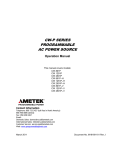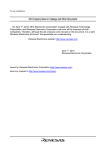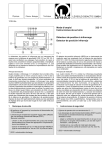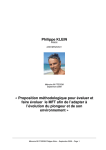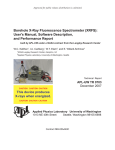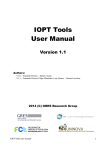Download Elgar CW 801P-V Specifications
Transcript
CW-P SERIES PROGRAMMABLE AC POWER SOURCE Programming Manual This manual covers models: CW 801P CW 1251P CW 2501P Contact Information Telephone: 800 733 5427 (toll free in North America) 858 450 0085 (direct) Fax: 858 458 0267 Email: Domestic Sales: [email protected] International Sales: [email protected] Customer Service: [email protected] Web: www.programmablepower.com March 2011 Document No. M161691-03 Rev E Contents Elgar CW-P Series CONTENTS SECTION 1 SCPI CONFORMANCE INFORMATION ........................... 1-1 1.1 Introduction ........................................................................................... 1-1 1.2 Parameter Definitions ........................................................................... 1-1 1.3 Units ...................................................................................................... 1-1 1.4 Conventions .......................................................................................... 1-2 1.5 Queries ................................................................................................. 1-2 SECTION 2 POWER-ON AND RESET CONDITIONS .......................... 2-1 2.1 Factory Defaults .................................................................................... 2-1 2.2 Power-On Conditions ............................................................................ 2-1 2.3 Reset Conditions ................................................................................... 2-2 2.4 Changing Voltage Ranges Via Command Interface ............................. 2-2 2.5 Changing Ranges During Recall Via Command Interface .................... 2-2 SECTION 3 SCPI COMMANDS ........................................................... 3-1 3.1 Miscellaneous Commands .................................................................... 3-1 3.2 MEASURE Commands ......................................................................... 3-1 3.3 OUTPUT Commands ............................................................................ 3-2 3.4 SOURCE Commands ........................................................................... 3-2 3.5 STATUS Commands ............................................................................ 3-4 3.6 SYSTEM Commands ............................................................................ 3-4 3.7 Master/Slave Commands ...................................................................... 3-5 3.8 Common Commands ............................................................................ 3-6 Programming Manual i Elgar CW-P Series Contents SECTION 4 RS-232 INTERFACE ......................................................... 4-1 4.1 RS-232 Interface Operation ................................................................. 4-1 4.2 RS-232 Characteristics......................................................................... 4-1 4.3 RS-232 Connector ................................................................................ 4-2 APPENDIX A: STATUS REGISTER DEFINITIONS ........................... A-1 A.1 Status Byte ........................................................................................... A-1 A.2 Standard Event Status Register ........................................................... A-2 A.3 Operation Status / Questionable Status Registers ................................ A-3 A.4 Error / Event Queue .............................................................................. A-3 A.5 Serial Poll Operation............................................................................. A-3 APPENDIX B: ERROR CODES ............................................................ B-1 B.1 Error Codes Returned by SYSTem:ERRor? Query .............................. B-1 B.2 SCPI Error Codes ................................................................................. B-1 APPENDIX C: SAMPLE PROGRAMS .................................................. C-1 ii Programming Manual SECTION 1 SCPI CONFORMANCE INFORMATION 1.1 Introduction This manual provides programming information for Elgar‟s ContinuousWave™ series programmable AC power sources. This manual is to be used in conjunction with the CW-P Series Programmable AC Power Source Operation Manual (Elgar Document No. M161691-01). The CW-P Series power sources conform to all specifications for devices as defined in IEEE 488.2, and comply with SCPI command syntax version 1995.0. 1.2 Parameter Definitions Type <boolean> 1.3 Valid Arguments ON, OFF, 0, or 1, HIgh, LOw <value> Integer or Floating point number <name> String enclosed by single or double quotes Units The CW Series accepts the following units as suffixes to numeric values: Type of Unit Valid Suffix Voltage “Volts” or “V” Current “Amps” or “A” Frequency Time Programming Manual “Hz” “ms” (milliseconds), “s” (seconds), or “min” (minutes) 1-1 SCPI Conformance Information 1.4 Elgar CW-P Series Conventions Commands enclosed by “[ ]” are optional. For example, SOURce:VOLTage:LEVel:IMMediate:AMPLitude 120.0 can be written as, SOURce:VOLTage 120.0. 1.5 Queries The query syntax is identical to the command syntax, with a ”?” appended. For example, to query the programmed voltage on phase A, send the string: SOURce:VOLTage? A subsequent device read will return a value such as “120.00”. All queries are terminated with a carriage return and line feed (0x0D 0x0A) for those GPIB controllers that require termination characters. When the CW unit has nothing to report, its output buffer will contain three ASCII characters: space, carriage return, and linefeed (in decimal these values are <32><13><10>). 1-2 Programming Manual SECTION 2 POWER-ON AND RESET CONDITIONS The following sections define the factory and reset power-on conditions of the unit. 2.1 Factory Defaults When the CW-P unit is first powered up, the following factory defaults will be in place: GPIB Address: 25 RS-232 Baud Rate: 9600 RS-232 Data Bits: 8 RS-232 Stop Bits: 1 RS-232 Parity: N 2.2 Power-On Conditions When the CW-P unit is first powered up, the system reads in the configuration that was last saved to memory position 0. The specific system items in Save and Recall are: VoltsA, VoltsB, VoltsC (B and C for multi-unit configuration) Voltage Range, either High or Low Current Protection Type, either Fold or Shut Current Shutdown Time Current LimitA, Current LimitB, Current LimitC (B and C for multi-unit configuration) Frequency Phase AngleAB Phase AngleAC External Input Assignment, either Analog In or Pulse Out. Programming Manual 2-1 Power-On and Reset Conditions Elgar CW-P Series In addition, unique system settings are read in from the non-volatile EEROM memory: Output Relay State, either Auto Start or Standby Keyboard Lock State, either Front Panel Program Enabled or Disabled Master/Slave status if part of a multi-unit configuration 2.3 Reset Conditions When the *RST command is sent via SCPI, the following conditions apply: Faults are cleared The error queue is cleared The output relay is opened VoltsA, VoltsB, VoltsC are set to 0 A locked keyboard remains locked. 2.4 Changing Voltage Ranges Via Command Interface When the voltage range is changed using the command interface: SOUR:VOLT:RANGE 1 If moving from low range to high range, and the output relay was initially in the closed state, the CW will open the output relay. In this case, the programmer must re-close the relay and set the new voltage. 2.5 Changing Ranges During Recall Via Command Interface Assume that the CW is in low range with the output relay closed and sourcing 100 volts. If a recall is performed: SYST:RECALL 33 And the recalled system state was initially saved in high range, the output relay will open, the new system values will be read into the CW parameters, the CW will shift into high range, and the output relay will re-close. The entire process takes approximately two seconds. The CW cannot change ranges seamlessly with the output relay closed during the transition. 2-2 Programming Manual SECTION 3 SCPI COMMANDS 3.1 Miscellaneous Commands :ASSYno? 3.2 Returns the assembly number. MEASURE Commands :MEASure [phase] :CURRent Measurement words, phase 1-3. Return measured current. :PEAK? Return the peak current measured. :INRUSH? Return the inrush current measured. :FREQuency? Return the frequency measured. :PEAKCURRent? Return the peak current measured. :POWer? Return presently calculated power in Watts. :POWer :TOTAL? :POWERFACtor? Return presently calculated power in Watts. Return the power factor measured. :POWERFACtor :TOTAL? Return the power factor measured. :CRESTFACtor? Return the crest factor measured. :VA? Return the Volt/Amps measured/calculated. :VA Return the Volt/Amps measured/calculated. :TOTAL? :VOLTage? Programming Manual Return the Volt/Amps measured/calculated. Return the RMS voltage. 3-1 SCPI Commands 3.3 Elgar CW-P Series OUTPUT Commands :OUTPut? Return the state of the output relay. :OUTPut <boolean> Set the output relay to open (OFF) or closed (ON). :OUTPut :STATe? Return the state of the output relay. :STATe <boolean> Set the output relay to open (OFF) or closed (ON). 3.4 SOURCE Commands :SOURce[phase] Power Supply source menu tree. :CURRent? Return the present current limit setpoint. :CURRent [<value>] Set foldback over-current mode and optionally specify the over-current value. :LEVel? Return the present current limit setpoint. :LEVel [<value>] Set over-current limit setpoint. :IMMediate [<value>] Process new amplitude without waiting for more commands. :AMPLitude <value> Set over-current limit setpoint. :AMPLitude? Return the present current limit setpoint. :PROTection? Return the present current limit setpoint amps. :PROTection [<value>] Specifies the over current shutdown mode and optionally can specify the over current value. :CLEar Clears the over-current protection circuit. :CURTimeout? :CURTimeout [<value>] 3-2 Programs the current level in current foldback mode and optionally sets the timeout value in milliseconds. :STATe? Return the present current limit. 0 = CW in foldback mode, 1 = shutdown mode :STATe <boolean> Program the over-current timeout circuit to enabled or disabled (foldback). :TIMe <value> Program the over-current timeout setpoint. :TIMe? Return the over-current timeout setpoint. :LEVel <value> Sets the over-current setpoint. :LEVel? Returns the over-current setpoint. :STATe <boolean> Set over-current active = ON, OFF to disable. :STATe? Return present over-current state. :TRIPped? Return 1 if the over-current circuit has tripped, 0 if not. Programming Manual Elgar CW-P Series SCPI Commands :FREQuency <value> Set the frequency of the CW. :FREQuency? Returns the frequency setpoint of the CW. :PHASe <value> Adjust phase 1, 2, or 3 phase angle offset from external trigger. :PHASe? Return the present phase angle setpoint. :VOLTage? Return the present voltage setpoint. :VOLTage [<value>] Set the voltage setpoint. :LEVel? Return the present voltage setpoint. :LEVel [<value>] Set the voltage setpoint. :IMMediate? Return the present voltage setpoint immediately without waiting for any other commands to be processed. :IMMediate [<value>] Set the voltage setpoint immediately without waiting for any other commands to be processed. :AMPLitude <value> Set the voltage setpoint. :AMPLitude? Return the present voltage setpoint. :PROTection? Return the overvolt protection of the CW. Always returns „1‟. :PROTection [<value>] Set the overvolt protection setpoint value. :LEVel <value> Set the overvolt protection setpoint value. :LEVel? Return the overvolt protection value. :STATe <boolean> Specify the overvolt protection state. 1 = protection turned on. 0 will be ignored. :STATe? Return the present overvolt state of the CW. Always will return „1‟. :TRIPped? Return the present state of the overvolt protection circuit. 0 = there has been no overvolt condition, 1 = CW has shut down due to an overvolt condition. :RANGe <value> Set the voltage range to HIGH range or LOW range :RANGe? Returns the present set voltage range of the CW. Return values will be either „1‟ or „0‟. :RMSLOOP <boolean> If set to „1‟ turns on RMS loop software. :RMSLOOP? Returns „1‟ if RMS loop software is enabled. Programming Manual 3-3 SCPI Commands 3.5 Elgar CW-P Series STATUS Commands :STATus The status commands tree. :OPERation? SCPI commands returns „1‟. :OPERation The SCPI Operation sub-tree. :[EVENt?] Returns „1‟. :CONDition? Returns „1‟. :ENABle <value> Sets the value in the Operations Enable register. :ENABle? Returns the value in the Operations Enable register. :PRESet Set the value of the Operations Enable register. :QUEStionable? Returns „1‟. :QUEStionable 3.6 :CONDition? Returns „1‟. [:EVENt?] Returns „1‟. :ENABle <value> Set the value of the Operations Enable register. :ENABle? Returns the value of the Operations Enable register. SYSTEM Commands :SYSTem The system command tree. :KLOCK? Returns „1‟ if the front panel programmable keys are locked out. :KLOCK <boolean> „1‟ locks the front panel programmable keys. :CHECKSUM? Returns the results of the checksum test. 1 = the checksum passed, 0 = failed. :CHECKSUM Specify that the CW shall re-check its flash checksum. :COMMunicate The communications sub-tree. :GPIB The GPIB communications channel. [:SELF] SCPI sub-command. :ADDRess <value> [<value>] Set the GPIB address to a value of 1..31. :ADDRess? 3-4 Returns the GPIB address presently set. :AUTORUN <value> „1‟ (ON) specifies the CW will automatically close the output relay at power-up. „0‟ (OFF) specifies the CW will power up in standby. :AUTORUN? Returns the state of the autorun parameter, either „0‟ or „1.‟ :STORe <value> Specify that the present system setpoint/ register set shall be saved to EEPROM at the <value> address. <value> shall be 0..98. Programming Manual Elgar CW-P Series SCPI Commands :STORe? Return the present EEPROM register address that was read to set the present setpoint/register values. CW shall read in EEPROM address 0 at power-up. :RECall <value> Specify that CW shall read in the EEPROM setpoint/registers from EEPROM location <value>. :ERRor? Return the last Error logged by the GPIB/ RS-232 command processor. If there are no errors, CW shall return as SPACE. :EXTernal External connectors sub-tree. :CLOCk? Return the present state of the Clock/Lock connector interface circuit. :CLOCk <description> „IN‟ sets the Clock/Lock connector interface to an input, „OUT‟ makes the pin an output. See Operation Manual for the pinout of connectors. :LOCK? Returns 1 if the Phase Lock Loop is in the acquired (locked) state. :ANAIN <boolean> „1‟ (ON) specifies that the CW amplifiers will slew 0 through programmed value in relation to a 0-5 volt control signal. See Operation Manual for connector pinouts. :ANAIN? Returns „1‟ if ANAIN is enabled. :SERIALNO? Returns the serial number. :VER[S][ion]? Return the code version of the FLASH application presently active in the CW. 3.7 Master/Slave Commands :SLAVECONFIG <description> Accepts A0A0,A0A1,A0A2,A0A3,A0A4,A0A5, A0B0,A0B1,A0B2,A0B3,A0B4,A0B5,A0C0, A0C1,A0C2,A0C3,A0C4,A0C5. See Operation Manual for usage of these master/slave configuration options. :SLAVECONFIG? Returns A0A0,A0A1,A0A2,A0A3,A0A4,A0A5, A0B0,A0B1,A0B2,A0B3,A0B4,A0B5,A0C0, A0C1,A0C2,A0C3,A0C4,A0C5. :SLAVEADDR <value> Accepts 0-5. See Operation Manual for usage. :SLAVEADDR? Returns 0-5. :SLAVECHAN <value> Accepts A,B,C. See Operation Manual for usage. :SLAVECHAN? Returns A-C. Programming Manual 3-5 SCPI Commands 3.8 Elgar CW-P Series Common Commands The following commands are common to all SCPI instruments and declared mandatory by IEEE 488.2. In the following table, the CW-P Series will be defined as the “device” on the GPIB bus. These commands are further supported on the RS-232 command interface. *CLS Clear Status Command. Clears all status reporting data structures, including the Status Byte, Standard Event Status Register and Error Queue. Enable Masks are not cleared. *ESE Standard Event Status Enable Command. Sets the Standard Event Status Enable Register, which determines which bits can be set in the Standard Event Status Register. *ESE? Standard Event Status Enable Query. Returns value of Standard Event Status Enable register. *ESR? Standard Event Status Register Query. Returns value of Standard Event Status Register. The ESR and the Status Byte ESR are cleared. *IDN? Identification Query. Returns the device identity as an ASCII string: <manufacturer>, <model>, <serial number>, <firmware version level>. Example: Elgar, CW801P, 1234FF345, 1.20 *OPC Operation Complete Command. Causes the Operation Complete bit to be set in the Standard Events Status Register when all pending operations are complete. *OPC? Operation Complete Query. Causes an ASCII „1‟ to be placed in the output queue when all pending operations are complete. *RST Reset Command. Resets the device to the state defined in section 2.3. Clears all status reporting data structures, including the Status Byte, Standard Event Status Register and Error Queue. Enable Masks are not cleared. *SRE Service Request Enable Command. Sets the Service Request Enable Register, which determines which bits in the Standard Event Status Register will cause a service request from the device. *SRE? Service Request Enable Query. Returns contents of Service Request Enable Register. Values range from 0 to 63 or 128 to 191. *STB? Read Status Byte Query. Returns the Status Byte with bit 6 representing the Master Summary Status (MSS) instead of RQS. The MSS bit acts as a summary bit for the Status Byte, and indicates whether or not the device has at least one reason to request service, based on the MAV and SESR bits. The return value is in the range of 0-255. The Status Byte is cleared after the read. *TST? Self Test Query. Causes the device to execute an internal self-test and report whether or not it detected any errors. A value of „0‟ indicates the test completed without detecting any errors. *WAI Wait to Continue command. Makes the device wait until all previous commands and queries are completed before executing commands following the *WAI command. 3-6 Programming Manual SECTION 4 RS-232 INTERFACE This section describes how to connect the CW-P for remote programming with a controller using the RS232 interface. The RS-232 interface provides a simpler 3-wire serial interface (compared to the GPIB parallel interface), while fully supporting the SCPI commands presented in Section 3. 4.1 RS-232 Interface Operation The CW-P uses a 3-wire connection to the controller: TxD, transmit data; RxD, receive data; GND, signal ground. When connecting the CW-P, appropriate consideration is required to ensure that the TxD line of the CW-P connects to the RxD line of the controller and the RxD line of the CW-P connects to the TxD line of the controller. See Section 4.3. The CW-P implements the XON/XOFF (Transmit On/Transmit Off) software protocol to control the flow of data between it and the controller. Under this protocol, the receiver (either the CW-P or the controller) controls when data is sent, and requests that the transmitter (controller or CW-P) stop sending data, if necessary. To enable data flow, the receiver sends an XON (ASCII 19) on its TxD line to the transmitter. To request that data flow be stopped, the receiver sends an XOFF (ASCII 17) to the transmitter. 4.2 RS-232 Characteristics The interface characteristics are listed below: Baud Rate: 9600 Data Bits: 8 Stop Bits: 1 Parity: None Protocol: XON/XOFF Programming Manual 4-1 RS-232 Interface 4.3 Elgar CW-P Series RS-232 Connector The RS-232 connector is a 9-pin male Subminiature-D type; its pinout is presented below: Pin Number 2 3 4 5 6 7 Function RxD, Receive Data TxD, Transmit Data Connected to Pin-6 Signal Ground Connected to Pin-4 Connected to Pin-8 Input/Output Input Output — — — — 8 Connected to Pin-7 — Not Used — 1,9 When connecting the CW-P to a controller, ensure that the RxD line of the CW-P connects to the TxD line of the controller, and that the TxD line of the CW-P connects to the RxD line of the controller. This could be accomplished using a null-modem cable. There are two versions of the null-modem cable: a 9-pin/9-pin and a 9-pin/25-pin. The 9-pin/9-pin cable swaps Pin-2 and Pin-3 between the two ends of the cable, so that the proper RxD and TxD connections are made, while the 9-pin/25-pin cable connects Pin-2 to Pin-2 and Pin-3 to Pin-3. Also, because the CW-P connector has Pin-4 connected to Pin-6, and Pin-7 connected to Pin-8, the null-modem cables would connect the following control lines: DSR to DTR and CTS to RTS. 4-2 Programming Manual APPENDIX A STATUS REGISTER DEFINITIONS The CW-P Series supports the IEEE 488.2 and SCPI 1993.0 status reporting data structures. These structures are comprised of status registers and status register enable mask pairs. These pairs are described below: A.1 Status Byte The Status Byte status register can be read by the *STB? command or by issuing a GPIB serial poll. Either operation clears the contents of the Status Byte. The *CLS command clears the Status Byte. The CW-P Series unit can be configured to request service from the GPIB controller by setting the appropriate bits in the Service Request Enable register. The SRE register has the same bit pattern as the Status Byte. The SRE register is modified using the *SRE command, and can be read with the *SRE? command. For example, if the SRE register is set to 0x10 (MAV), when the CW-P unit has a message available, the Status Byte register will contain 0x50 (RQS and MAV) and the SRQ line of the GPIB bus will be pulled low indicating a request for service. Bit Hex Value 0 01 Not used. 1 02 Not used. 2 04 Error/event queue message available. 3 08 Questionable Status flag. Indicates quality of current data being acquired. This bit is not used. 4 10 Message available (MAV). 5 20 Standard Event Status Register (ESR). 6 40 Request Service flag (RQS) for serial polling, or Master Summary Status (MSS) in response to *STB? 7 80 Operation Status flag. Indicates the current operational state of the unit. This bit is not used. Programming Manual Description A-1 Status Register Definitions Elgar CW-P Series Bit 2, Error/Event Queue Information Available This bit is set when any error/event is entered in the System Error queue. It is read using the SYSTem:ERRor? query. Bit 4, Message Available Indicates a message is available in the GPIB output queue. This bit is cleared after the GPIB output buffer is read. Bit 5, Standard Event Status Register This is a summary bit for the ESR. It is set when any of the ESR bits are set, and cleared when the ESR is read. Bit 6, Request Service/Master Summary Status If service requests are enabled (with the *SRE command), this bit represents the RQS and will be sent in response to a serial poll, then cleared. If RQS is not enabled, the bit represents the MSS bit and indicates the device has at least one reason to request service. Although the device sends the MSS bit in response to a status query (*STB?), it is not sent in response to a serial poll. It is not considered part of the IEEE 488.1 Status Byte. A.2 Standard Event Status Register The ESR can be read by the *ESR? command. Reading this register, or using the *CLS command will clear the ESR. Bits in the ESR will be set only when the corresponding bit in the Standard Events Status Enable register is set. Use the *ESE to set bits, and the *ESE? to read this register. To configure the CW-P Series to generate SRQ's based on the ESR, both the Standard Event Status Enable register and the Service Request Enable registers must be programmed. A-2 Bit Hex Value Description 0 01 Operation Complete. 1 02 Request Control - Not used. 2 04 Query Error. 3 08 Device-Dependent Error. 4 10 Execution Error (e.g., range error). 5 20 Command Error (e.g., syntax error). 6 40 User Request - Not used. 7 80 Power On. Programming Manual Elgar CW-P Series Status Register Definitions Operation Complete Set whenever the last command is completed and the CW is ready to accept another command, or when query results are available. Query Error Set when a query is made for which no response is available. Device-Dependent Error Set for device-specific errors. These errors are entered in the System Error Queue and have error codes greater than 0. See Appendix B for error descriptions. Execution Error Set when a parameter exceeds its allowed range. Command Error Set for a syntax error. Power On Set once at power-up. The Status Byte ESR bit is not set. A.3 Operation Status / Questionable Status Registers The Operation Status and Questionable Status registers always return 0 when queried. The Operation Status Enable and Questionable Status Enable registers can be programmed and queried to allow SCPI compatibility, but have no effect on the Operation Status and Questionable Status registers. A.4 Error / Event Queue The CW Series maintains an Error/Event Queue as defined by SCPI. The queue holds up to 10 errors and events. It is queried using the SYSTem:ERRor? command, which reads in a first in, first out manner. The read operation removes the entry from the queue. The *CLS command clears all entries from the queue. A.5 Serial Poll Operation Performing a serial poll will not modify the Status Byte other than to clear the RQS (bit 6) for a CW requesting service. Queries affecting the status registers and subsequent serial polls are described below: *STB? clears the Status Byte *ESR? clears the ESR and bit 5 of the Status Register SYSTem:ERRor? clears bit 2 of the Status Register if the queue is empty. Programming Manual A-3 Status Register Definitions Elgar CW-P Series This page intentionally left blank. A-4 Programming Manual APPENDIX B ERROR CODES B.1 Error Codes Returned by SYSTem:ERRor? Query The following error codes are defined in the SCPI 1993.0 specification, and are supported by the CW-P Series. Error codes are in the range of [-32768, 32767]. SCPI reserves the negative error codes and 0, while error codes greater than 0 are device-specific errors. Additionally, in multiphase system applications where multiple units are interconnected for generating polyphase outputs, the error codes will also note which unit of the system experienced the fault condition. An example is a response to the SYST:ERR? Command is: <Fault Code Number>, [Fault Condition] ; source #x where x=the unit in a multiple unit system. B.2 SCPI Error Codes 0, No error The error queue is empty. -102, Syntax error An unrecognized command or data type was encountered. Programming Manual B-1 Error Codes Elgar CW-P Series -200, Execution error An error/event number in the range [-299, -200] indicates that an error has been detected by the instrument’s execution control block. The occurrence of any error in this class shall cause the execution error bit (bit 4) in the event status register to be set. An execution error can be the result of: A <program data> element out of range, such as programming 200 volts in low (156 volt) range. A command could not be executed due to the current condition of the device, such as attempting to change ranges while the output relay is closed. The output relay must be opened first. -292, Referenced name does not exist -330, Self-test failed -345, Overcurrent Occurred; source #x Indicates that the CW shutdown because the programmed current limit levels were met or exceeded. Source #x where x=CW Unit that saw the overcurrent condition in a multiphase system application. -346, Overvoltage Occurred; source #x Indicates that the CW shutdown because the programmed voltage limit levels were met or exceeded. Source #x where x=CW Unit that saw the overvoltage condition in a multiphase system application. -347, Hardware Fault; source #x Indicates that the CW shutdown because of hardware protection circuits internal to the CW Unit or others in a multiphase system application. The hardware fault condition may be caused from a number of internally detected faults. Source #x where x=CW Unit that saw the overvoltage condition in a multiphase system application. -350, Queue overflow The error queue can contain up to 10 entries. If more than 10 error/event conditions are logged before the SYSTem:ERRor? query, an overflow will occur; the last queue entry will be overwritten with error -350. When the queue overflows, the least recent error/events remain in the queue and the most recent errors/events are discarded. B-2 Programming Manual APPENDIX C SAMPLE PROGRAMS The following examples will illustrate how to perform certain functions on the CW-P using SCPI via the GPIB interface or the RS-232 channel. NOTE: See the CW-P Series Operation Manual for examples of how to use Slave commands. 1. Source AC from power up SOUR:VOLT:RANGE LOW SOUR:CURR 3 SOUR:VOLT 120 SOUR:FREQ 60 OUTP ON Specify low range 0-156V 13 Amps Specify 3 Amps current limit; foldback mode Specify 120 VAC setpoint Specify 60 Hz frequency Source power to the output 2. Turn off Front Panel Programmability SYST:KLOCK ON (1) Lock the program keys out 3. Turn on Front Panel Programmability SYST:KLOCK OFF (0) Front panel program keys now function 4. Provide Zero Crossing pulses from Phase A SYST:EXT:CLOCK OUT 5. Phase Lock Loop clock input SYST:EXT:CLOCK IN 6. Turn on External Analog Gain control SYST:EXT:ANAIN ON (1) 7. Turn off External Analog Gain control SYST:EXT:ANAIN OFF (0) Programming Manual C-1 Sample Programs Elgar CW-P Series 8. Turn On RMS loop SOUR:VOLT:RMSLOOP ON (1) 9. Turn Off RMS loop SOUR:VOLT:RMSLOOP OFF (0) 10. Turn Off RMS loop SOUR:VOLT:RANGE LO SOUR:VOLT 120 OUTPUT ON The CW-P will source 120V to the output terminals in low range. If you send the command: If you send the command: SOUR:VOLT:RANGE HI 11. The output relay will open, the voltage will drop to zero. If the CW-P supply is sourcing to the output terminals (output relay closed, voltage>0), and you send the command: SYST:RECALL 31 (any number 0..99) When the recalled parameters are in the same range that the CW-P is presently operating in, the output relay will remain closed, and the voltage, phase, current limit, etc. will go to the new values. When the recalled parameters are in the opposite range (LOW, HIGH) that the CW-P is presently operating in, the output relay will remain open, delay one second, and then reclose. Then CW-P then will go to the new recalled parameters. C-2 Programming Manual

























